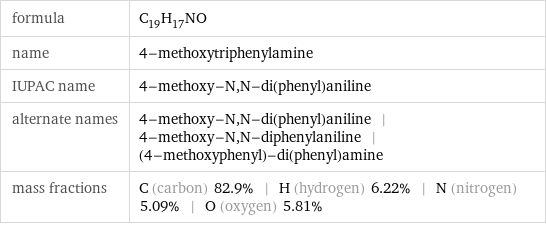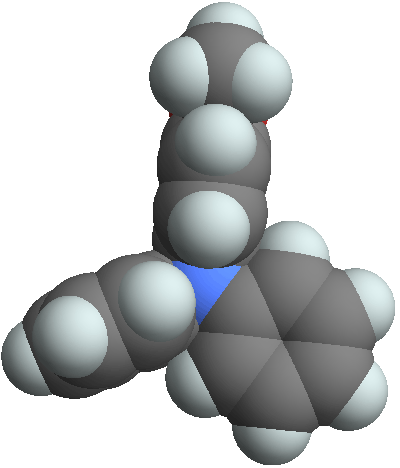Input interpretation

4-methoxytriphenylamine
Chemical names and formulas

formula | C_19H_17NO name | 4-methoxytriphenylamine IUPAC name | 4-methoxy-N, N-di(phenyl)aniline alternate names | 4-methoxy-N, N-di(phenyl)aniline | 4-methoxy-N, N-diphenylaniline | (4-methoxyphenyl)-di(phenyl)amine mass fractions | C (carbon) 82.9% | H (hydrogen) 6.22% | N (nitrogen) 5.09% | O (oxygen) 5.81%
Lewis structure

Draw the Lewis structure of 4-methoxytriphenylamine. Start by drawing the overall structure of the molecule, ignoring potential double and triple bonds: Count the total valence electrons of the carbon (n_C, val = 4), hydrogen (n_H, val = 1), nitrogen (n_N, val = 5), and oxygen (n_O, val = 6) atoms: 19 n_C, val + 17 n_H, val + n_N, val + n_O, val = 104 Calculate the number of electrons needed to completely fill the valence shells for carbon (n_C, full = 8), hydrogen (n_H, full = 2), nitrogen (n_N, full = 8), and oxygen (n_O, full = 8): 19 n_C, full + 17 n_H, full + n_N, full + n_O, full = 202 Subtracting these two numbers shows that 202 - 104 = 98 bonding electrons are needed. Each bond has two electrons, so in addition to the 40 bonds already present in the diagram add 9 bonds. To minimize formal charge carbon wants 4 bonds. Identify the atoms that want additional bonds and the number of electrons remaining on each atom: Fill in the 9 bonds by pairing electrons between adjacent highlighted atoms. Note that the six atom rings are aromatic, so that the single and double bonds may be rearranged: Answer: | |
3D structure

3D structure
Basic properties

molar mass | 275.35 g/mol phase | solid (at STP) melting point | 104 °C
Units

Chemical identifiers

CAS number | 4316-51-2 PubChem CID number | 9882037 PubChem SID number | 24883435 SMILES identifier | COC1=CC=C(C=C1)N(C2=CC=CC=C2)C3=CC=CC=C3 InChI identifier | InChI=1/C19H17NO/c1-21-19-14-12-18(13-15-19)20(16-8-4-2-5-9-16)17-10-6-3-7-11-17/h2-15H, 1H3 MDL number | MFCD03929020